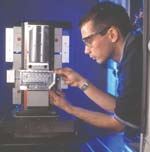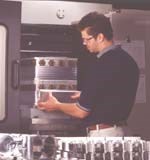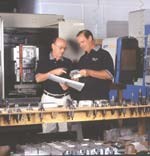A New Orientation
How a previously vertical-only shop made the transition to horizontal milling.
Share





Larry Osier didn’t get a chance to question whether his shop should go horizontal. He didn’t have much of a choice.
For the first 20 years of his company’s existence, Mr. Osier had found success running a small machine shop with an accent on tackling difficult projects and providing quick turnaround times. As orders from customers grew, he kept pace by expanding his shop first to 10,000 square feet, then to 23,000.
His equipment was the usual mix of machine tools found in most job shops, with an emphasis on milling that mirrored the requirements of his customers. His CNC milling machines were all verticals—easy to set up and break down, and powerful and dependable.
But when a customer bumped up its order for a complicated machined part from 300 per week to 1,200, Mr. Osier knew he didn’t have adequate floor space to suddenly add three vertical machining centers to the one already working 24 hours every day on this project. And finding the extra skilled labor for three shifts a day wouldn’t be easy.
It was time to try something new. It was time to enter the world of horizontal machining.
Change Of Direction
Located less than a mile from the Atlantic Ocean in Rockport, Massachusetts, Sandy Bay Machine is a 24-year-old job shop that has done milling work primarily for customers in the telecommunications, military and medical fields. By operating round-the-clock, says Mr. Osier, the company has been able to be very competitive in its pricing to win new jobs. But Sandy Bay’s biggest advantage has been its willingness to accept jobs that other machine shops might avoid.
“Our reputation is that we can build what others have trouble building,” says Mr. Osier. “We have some very talented people here, so we don’t mind taking on the tough projects. We’ll sit down with the customer to try to help them engineer their part so that it will be machined just the way they want it—and in the most cost-effective way.”
It was such a collaboration that helped Sandy Bay win a job machining an intricate part for a microwave housing. The sheer volume of cutting that needed to be performed to complete each piece forced Mr. Osier and his programmers to think creatively to engineer a new solution.
The part was only a few inches long and less than a half-inch high, but it required significant stock removal, leaving very thin walls and extremely precise edges. Even the depths had to be held to a tight tolerance—a difficult assignment given the heat generated by a prolonged cutting process.
When the project was first awarded to Sandy Bay in 1997, the company purchased a vertical machining center customized specifically for this job and ran it 24 hours a day. “We went with a double-station vise,” says Mr. Osier. “We put four of them on one machine, and that gave us eight locations—enough to program a fairly productive cycle.
The cycle time allowed the company to ship 300 parts per week. When the customer committed to 500 parts per week, the company added another VMC and configured it the same way.
“Then the customer started talking about a thousand or more parts per week,” says Mr. Osier.
His initial reaction was to see if adding pallet changers to the verticals would give him the required productivity increase, but the time gains weren’t enough. Then he looked for a way to squeeze two or three more VMCs onto the floor of his shop. But it was the president of his machine tool supplier, David Shaby of CompuMachine (Wilmington, Massachusetts) who suggested an alternative. Mr. Shaby offered to conduct a time study on the project. To Mr. Osier, the result was shocking: an estimated cycle time of 14 minutes per part could be achieved—dramatically shorter than the cycle time on the vertical—using a horizontal machining center.
As someone who had spent his career and built his business largely using vertically oriented machine tools, Mr. Osier was comfortable with the way they worked and with the results they provided. He understood that horizontals were well suited for deep-pocket milling and for multi-plane machining. He knew they could be very fast and efficient for certain batch jobs. But he also thought they were expensive, complicated and required a steep learning curve for the programmers and operators. If he bought one he would be making a large investment to serve this one job. And if the project should end, the machine would sit idle on his shop floor.
“A horizontal—that’s the kind of machine used by a company like Boeing,” Mr. Osier recalls of his thoughts at the time. “It’s not a machine for a small company like ours.”
Mr. Shaby allayed those fears. Yes, horizontals historically have had high acquisition and operating costs, but thanks to advances in machine tool technology, the cost of a horizontal has come down in recent years. This cost reduction widens the range of jobs for which a horizontal can now be considered. And new computer technology has produced easy-to-use controls, allowing the operation of a new HMC to be as easy as that of an older VMC.
Mr. Osier spoke with his programmers and machinists about their concerns. After taking a deep breath, he ordered a horizontal machining center and cleared the space on his floor.
Making It Work
The first challenge in preparing for the job was in designing the fixturing. Mr. Osier wanted to extend the unattended operation of the new machine to as long as possible, so the applications engineers at CompuMachine developed an aluminum tombstone capable of holding 24 pieces at a time. The fixture left clearance for parts to be machined from the side by indexing the pallet.
The programming was performed using Mastercam. Working with Sandy Bay’s programmers, Mr. Shaby noticed that their mindset was still vertically oriented. “It takes time for people to start thinking about cutting a whole array of parts at one time” he says. However, much of the setup procedure for any machining operation is the same whether it’s for a vertical or a horizontal. “I tell people, if you look at the vertical while lying on your side, it’s the same as a horizontal.”
The period while the new machine was in place but not yet operational was an anxious one. Mr. Shaby remembers within the first few weeks receiving a phone call from Mr. Osier telling him to “get this thing out of here.”
Mr. Osier insists that plea was light-hearted. Still, “to get the new machine up and running took 6 weeks,” he says. “We would program, cut, make 24 inspections—one for each part on the tombstone—and then make adjustments for each piece. We were hoping this would all work, but we didn’t absolutely know we could do it.”
But when the machine was ready, it was really ready. In the first 24 hours of operation the horizontal machined 144 parts—something three vertical machines operating simultaneously for the same period of time would not have been able to do. The average cycle time per part was reduced to 9 minutes—even better than the time study had predicted. Changeovers were reduced from eight to three. In addition, the machine never stopped cutting. As it was milling 24 parts on one pallet, the other pallet was being unloaded and re-loaded with 24 more parts.
“But we weren’t just unloading parts,” says Mr. Osier. “We were harvesting them. It was as simple as picking up a tray and taking it off to deburring.”
Mr. Osier was the most pleased with the machine’s capability to run for long periods without operator attention. “The most important thing you can do in machining is to eliminate manpower,” he says. “It’s just too expensive.”
Such long runs created new challenges. One related to stock removal. “This project sheds a lot of chips,” says Mr. Osier. Adding a chip conveyor to the machine was not enough. The Sandy Bay machinists also tried little tricks, such as strategically aiming the coolant spigots so that the chips all fell to one side of the working chamber and onto the conveyor. But with 24 parts being cut in one cycle, the volume of chips was so great that Mr. Osier decided to invest in a “fine” chip conveyor—essentially a chip conveyor inside a chip conveyor—that could handle the volume.
Another area of concern was potential tool breakage. CompuMachine responded by outfitting the horizontal with a laser tool breakage detection system that can be used to automatically detect the need for tool replacement.
Somewhat surprisingly to the Sandy Bay staff, it was not difficult to program the HMC to achieve parts cut as cleanly as if they had been machined on a vertical under close operator attention. “We try to take the parts off the machine as close to burr-free as possible,” says Mr. Osier. “With the horizontal, like the vertical, there is little need for deburring.”
Once the bugs were ironed out, Mr. Osier says everyone in the shop wondered why they had been so nervous about horizontal machining to begin with. It was just another tool, albeit a very powerful one.
The Payoff
Horizontal machining had yet another impact on the company. Thanks to word-of-mouth referrals by existing customers, Mr. Osier found that suddenly he was in demand among new customers who had jobs with specs suited for horizontal machining.
He added another horizontal. And then another. In short order, Sandy Bay had six horizontal machining centers from CompuMachine on its shop floor, and Mr. Osier plans to add more as soon as a newly planned 10,000 square foot addition is complete.
Mr. Osier is now a big proponent of multiple-workpiece, multiple-pallet machining. The benefits are many:
- Time. Given the company’s 24-hour operation, the completion time for any project is greatly shortened. There is almost no downtime for the machine. “On the horizontal, you never stop cutting,” he says.
- Labor. Aside from the loading/unloading of a finished pallet, and occasional operating checks, the machines require little attention. On Sandy Bay’s floor, one machinist can easily supervise three or four machines. “We have decreased our man-hours dramatically,” Mr. Osier says.
- Cost of operation and maintenance. Given the right project, “one horizontal can do the work of four verticals,” he says. That saves electricity and maintenance costs, plus indirect costs such as floor space, fixturing and programming time. But for a horizontal to work right it needs to be equipped with a good clamping mechanism and sturdy tools. “Don’t try to make do with cheap accessories,” he says.
- Flexibility. “We have more options now,” says Mr. Osier. “I find the horizontals to be the best for volume, but they can also be used for short-run jobs. They can be set up and programmed easily—just as fast as you can get a vertical up and running. Even if you have a small quantity job, you can cut the parts in a horizontal—but you can’t make it too complicated.”
These days at Sandy Bay, there is a new mindset—not only for management but also for programmers and machinists. Mr. Osier notes with satisfaction that employees are now approaching him to ask if they can become more involved with the horizontal program.
“Everyone realizes the machines are just as user-friendly as verticals,” he says.
What’s more, the capability that was originally purchased for a single job can now be considered for any new project that comes in the door.
Related Content
5 Tips for Running a Profitable Aerospace Shop
Aerospace machining is a demanding and competitive sector of manufacturing, but this shop demonstrates five ways to find aerospace success.
Read MoreHow to Mitigate Chatter to Boost Machining Rates
There are usually better solutions to chatter than just reducing the feed rate. Through vibration analysis, the chatter problem can be solved, enabling much higher metal removal rates, better quality and longer tool life.
Read MoreInside a CNC-Machined Gothic Monastery in Wyoming
An inside look into the Carmelite Monks of Wyoming, who are combining centuries-old Gothic architectural principles with modern CNC machining to build a monastery in the mountains of Wyoming.
Read MoreHigh RPM Spindles: 5 Advantages for 5-axis CNC Machines
Explore five crucial ways equipping 5-axis CNC machines with Air Turbine Spindles® can achieve the speeds necessary to overcome manufacturing challenges.
Read MoreRead Next
5 Rules of Thumb for Buying CNC Machine Tools
Use these tips to carefully plan your machine tool purchases and to avoid regretting your decision later.
Read MoreSetting Up the Building Blocks for a Digital Factory
Woodward Inc. spent over a year developing an API to connect machines to its digital factory. Caron Engineering’s MiConnect has cut most of this process while also granting the shop greater access to machine information.
Read MoreRegistration Now Open for the Precision Machining Technology Show (PMTS) 2025
The precision machining industry’s premier event returns to Cleveland, OH, April 1-3.
Read More

































